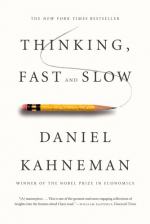
|
| Name: _________________________ | Period: ___________________ |
This test consists of 15 multiple choice questions and 5 short answer questions.
Multiple Choice Questions
1. What term is used to describe the adoption and termination of task sets by psychologists?
(a) Subconscious control.
(b) Executive control.
(c) Cognitive Pupillometry.
(d) Active control.
2. In the first description of the fictional Linda, Kahneman and Tversky said that she was how old?
(a) 26.
(b) 31.
(c) 35.
(d) 19.
3. Who is described as the editor for the online magazine Edge that asked scientists to report their favorite equation?
(a) Christopher Hsee.
(b) John List.
(c) Gary Klein.
(d) John Brockman.
4. What psychologist described the pupil of the eye as a window to the soul in Scientific American?
(a) Larry Jacoby.
(b) Eckhard Hess.
(c) Mihaly Csikszentmihalyi.
(d) Nassim Taleb.
5. In the example where the author presents two candidates for a college professorship, which individual is described as having held a postdoctoral position for the last three years?
(a) Anne.
(b) Jane.
(c) Jennifer.
(d) Kim.
6. In the experiment conducted at the University of Michigan by Richard Nisbett, how many of the 15 participants responded immediately to the stooge's plea for help?
(a) 13.
(b) 4.
(c) 7.
(d) 9.
7. Where was Albert Michotte from?
(a) Belgium.
(b) Norway.
(c) Sweden.
(d) France.
8. In the conclusion of the study of availability bias conducted by Paul Slovic, Sarah Lichtenstein, and Baruch Fischoff, they deduced that estimates of causes of death are warped by what?
(a) Family history of illness.
(b) Media coverage.
(c) The economy.
(d) Direct knowledge.
9. What does the author claim newspaper headlines do?
(a) Satisfy the need for coherence.
(b) Garnish attention from actual news.
(c) Entertain and enlighten.
(d) Inform of facts.
10. Amos Tversky, Tom Gilovich, and Robert Vallone conducted a study of misperceptions and randomness in what sport?
(a) Tennis.
(b) Football.
(c) Basketball.
(d) Soccer.
11. What do we lose touch with when we are uncomfortable or unhappy?
(a) Admiration.
(b) Intuition.
(c) Recognition.
(d) Articulation.
12. When the author demonstrates enlisting cognitive ease when writing, he gives two statements about Adolf Hitler. Which of these statements APPEARED to be the most legitimate?
(a) The statement in small print.
(b) The statement in italics.
(c) The statement in bold print.
(d) The statement in wide-set print.
13. What does the author claim the main function of System 1 is in Chapter 6?
(a) To categorize numbers and letters and find associations between them.
(b) To calculate difficult problems such as math equations.
(c) To grasp large concepts in relation to small concepts.
(d) To maintain and update a model for one's personal world.
14. The author provides an excerpt related to "norm theory" that comes from an essay he had written with what psychologist?
(a) Danny Oppenheimer.
(b) Daniel Gilbert.
(c) Shane Frederick.
(d) Dale Miller.
15. What word is used to describe when people fail to apply a logical rule that is obviously relevant?
(a) Artifact.
(b) Fallacy.
(c) Heuristic.
(d) Axiom.
Short Answer Questions
1. What does the author suggest when quoting sources in persuasive writing?
2. Based on the law of least effort, the author concludes that what characteristic is built deep into our nature?
3. Who created the Remote Association Test to study creativity?
4. Who introduced the word "flow" to describe the state of effortless attending?
5. What example is presented in the opening of Chapter 1 to demonstrate slow thinking?
|
This section contains 531 words (approx. 2 pages at 300 words per page) |

|




